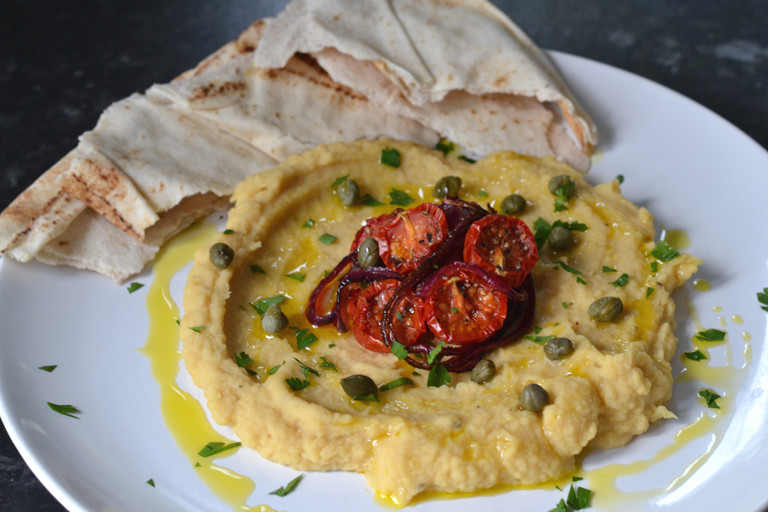Yellow split pea purée with slow roast Piccolo tomatoes, caramelised onion and capers
- medium
- 6
- 3 hours
Similar to the traditional Greek fava dip, Danny Kingston's yellow split pea purée makes a fantastic savoury snack or can be served as part of a mezze feast. The creamy yellow purée is the perfect base for sweet, slow roasted tomatoes and caramelised red onions, all ready to be scooped up with warm flatbreads.
Battles are often fought and won at the dinner table and at present, a small war is being waged in a kitchen, in Essex. On one side stands a little boy, mischievous yet cherub-like and with a smattering of freckles across his nose. On the other, stands a man, slightly stout and bald but curiously charismatic nevertheless, and who should really have the last word on all matters in the household. However, no-one ever seems to take him seriously at home.
The main sticking point, or bone of contention, revolves around the humble tomato. A fruit that the man loves and adores, in all its states. Be it raw or cooked. As the centre star or hidden in the background, doing valuable (yet often unrewarded work) in a sauce or stew. He grows tomatoes in his garden. He talks to them. His neighbours have seen him talking to them. And they are clearly worried about him.
The boy hates them. Actually no, he doesn’t hate them but he isn’t really fond of them. Hours have been spent, sifting through the complex debris of a dish and one by one they often get plucked out, to be left all forlorn, on the side of the plate. Enquiries are constantly made, to which deceitful answers are given. But he always finds out. ‘Liar, liar, pants on fire.’ On the other hand, tomatoes that have been squished, boiled and drenched with sugar and vinegar to make ketchup, well that is absolutely fine. This makes the man mad.
Small steps are being made though. That tomatoes go into ‘spag bol’ was deemed revolutionary the other day. ‘Really? From those tins?’ A pan of baked eggs, surrounded by a sea of scarlet, and pepped up with chilli and oregano, gets eaten with such gusto these days that the man dares not whisper the T-word. Slow cooked tomatoes though, they have been the real eye opener. Halfway between raw and cooked, they were observed with much suspicion at first but explained as a sort of cousin of raisins, sort of made sense. And raisins are good to eat, by all accounts.
Sat on a purée of earthy yellow split peas, a traditional dish often found in Greek tavernas (called fava) and paired with tangy slices of caramelised red onion, contrasting salty capers and parsley, the sweet roast tomato works in perfect harmony. Being able to scoff and slurp using warm flatbreads suddenly makes everything fun too.
‘I love this Dad and the tomatoes too, it all tastes really good together.’
‘Well, that’s agra-dolce for you son.’
‘Agra-dolce? What, that’s the name of the tomatoes?’
‘Oh no, these ones are called piccolo.’
So despite that initial confusion, the tomato war looks to be nearly over and peacetime in an Essex kitchen should be achieved real soon.
Ingredients
Metric
Imperial
Yellow split pea purée
- 400g of yellow split peas
- 1 onion, finely chopped
- 4 garlic cloves, finely chopped
- 1 bay leaf
- 1 lemon, juiced (or a lime would also work)
- 40ml of olive oil
- water, to cover
- salt
- freshly ground black pepper
Slow roast tomatoes
- 200g of Piccolo tomatoes, halved
- 10g of caster sugar
- 10g of salt
- 10g of freshly ground black pepper
Caramelised onions
- 2 red onions, sliced into rounds
- 25g of caster sugar
- 25ml of olive oil
- 25ml of pomegranate molasses
To serve
- 50g of capers, drained
- 1 bunch of flat-leaf parsley, roughly chopped
- olive oil, for drizzling
- 6 flatbreads, warmed to serve
Method
- 200g of Piccolo tomatoes, halved
- 10g of caster sugar
- 10g of salt
- 10g of freshly ground black pepper
- 20ml of olive oil
- 1 onion, finely chopped
- 4 garlic cloves, finely chopped
- 400g of yellow split peas
- 1 bay leaf
- water, to cover
- 2 red onions, sliced into rounds
- 25g of caster sugar
- 25ml of olive oil
- 25ml of pomegranate molasses
- 1 lemon, juiced (or a lime would also work)
- 20ml of olive oil
- 50g of capers, drained
- 1 bunch of flat-leaf parsley, roughly chopped
- olive oil, for drizzling
- 6 flatbreads, warmed to serve
Get in touch
Please sign in or register to send a comment to Great British Chefs.



